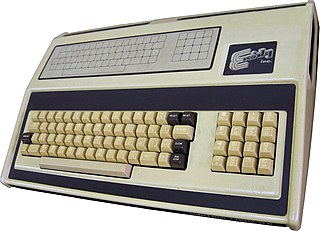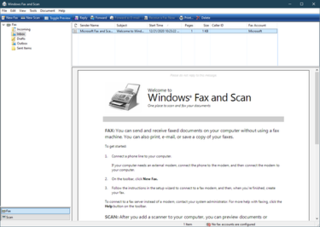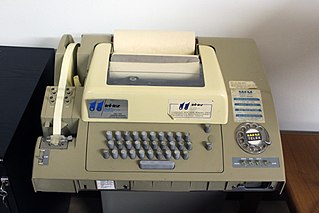
Stofor, pronounced as in "Stow Four", is a store and forward message switching system designed by Fenwood Designs Ltd, UK in 1980.

Stofor, pronounced as in "Stow Four", is a store and forward message switching system designed by Fenwood Designs Ltd, UK in 1980.
Stofor was aimed squarely at the bottom end of the market and its competitors were from companies such as Chernikeeff (now John Lilley and Gillie Ltd) and Racal but Stofor was soon outselling both with ease. The Stofor range was based on a 4 MHz Zilog Z80 processor with 64K RAM and provided from 4 to 64 ports. Early models, and some later ones, were floppy disk based but later and larger versions had 10Mb Winchester technology hard disks for storage. Stofor was the only message switching system of its size to boast a custom text editor designed by Fenwood with the needs of the telex user in mind. Its main workload was in the sending and receiving of telex messages but it was also put to work in a wide range of other communications areas including fax.
The initial design was for a system that would replace a London commodity broker's antiquated telex room, containing 12 telex machines, with a computer for sending and receiving messages plus a number of VDUs (computer displays) for preparing and editing messages. The resulting Stofor system was an instant hit and many orders were placed when the broker's associates and competitors saw the system in operation. Additional options such as direct input from dedicated word processors, leased line working and several other features were soon requested and incorporated.
Stofor became very popular in the City of London and was in use by banks, shipping brokers, commodity traders and insurance companies. Digital Equipment Corporation used one as the centre of its European message distribution network in Reading and others were in use by a number of household names in the food, chemical and engineering industries. Several were supplied to INMARSAT to provide telex links via satellite for ships at sea, and to the Lockheed subsidiary Memrykord, who provided international flight-planning services. [1]
When Stofor was born, Fenwood employed about six staff but this grew rapidly until there were forty eight, covering all aspects such design, procurement, production, software writing, sales and customer support. Sadly, with the rapid growth of fax and then the advent of email, demand for message switching systems such as Stofor died away and Fenwood moved into other markets, finally being wound up in the late 1990s. During their 'lives' Fenwood and Stofor were based in Farncombe, Godalming, Guildford; all in Surrey, UK and in Aldershot, Hampshire, UK.
Stofor was the result of work by Fenwood's three directors: John Kashel, Sales and marketing director, who came up with the concept and basic specification; Bob Fearnley, Technical Director, who designed the hardware and Tom Grainger, Software Director, who wrote the software. The original software for the product had been written by a third party but, as they let Fenwood down badly on delivery dates, Tom Grainger completed the job and eventually rewrote all the software in-house.

The Commodore 64, also known as the C64 or the CBM 64, is an 8-bit home computer introduced in January 1982 by Commodore International. It has been listed in the Guinness World Records as the highest-selling single computer model of all time, with independent estimates placing the number sold between 12.5 and 17 million units. Volume production started in early 1982, marketing in August for US$595. Preceded by the Commodore VIC-20 and Commodore PET, the C64 took its name from its 64 kilobytes(65,536 bytes) of RAM. With support for multicolor sprites and a custom chip for waveform generation, the C64 could create superior visuals and audio compared to systems without such custom hardware.

Fax, sometimes called telecopying or telefax, is the telephonic transmission of scanned printed material, normally to a telephone number connected to a printer or other output device. The original document is scanned with a fax machine, which processes the contents as a single fixed graphic image, converting it into a bitmap, and then transmitting it through the telephone system in the form of audio-frequency tones. The receiving fax machine interprets the tones and reconstructs the image, printing a paper copy. Early systems used direct conversions of image darkness to audio tone in a continuous or analog manner. Since the 1980s, most machines modulate the transmitted audio frequencies using a digital representation of the page which is compressed to quickly transmit areas which are all-white or all-black.

A teleprinter is an electromechanical device that can be used to send and receive typed messages through various communications channels, in both point-to-point and point-to-multipoint configurations. Initially they were used in telegraphy, which developed in the late 1830s and 1840s as the first use of electrical engineering, though teleprinters were not used for telegraphy until 1887 at the earliest. The machines were adapted to provide a user interface to early mainframe computers and minicomputers, sending typed data to the computer and printing the response. Some models could also be used to create punched tape for data storage and to read back such tape for local printing or transmission.

The Sorcerer is a home computer system released in 1978 by the video game company Exidy. Based on the Zilog Z80 and the general layout of the emerging S-100 standard, the Sorcerer was comparatively advanced when released, especially when compared to the contemporary more commercially successful Commodore PET and TRS-80. The basic design was proposed by Paul Terrell, formerly of the Byte Shop, a pioneering computer store.

The Family Computer Disk System, commonly shortened to the Famicom Disk System or just Disk System, is a peripheral for Nintendo's Family Computer home video game console, released only in Japan on February 21, 1986. It uses proprietary floppy disks called "Disk Cards" for cheaper data storage and it adds a new high-fidelity sound channel for supporting Disk System games.
The Western Union Company is an American multinational financial services company, headquartered in Denver, Colorado.
A voicemail system is a computer-based system that allows users and subscribers to exchange personal voice messages; to select and deliver voice information; and to process transactions relating to individuals, organizations, products, and services, using an ordinary phone. The term is also used more broadly to denote any system of conveying a stored telecommunications voice messages, including using an answering machine. Most cell phone services offer voicemail as a basic feature; many corporate private branch exchanges include versatile internal voice-messaging services, and *98 vertical service code subscription is available to most individual and small business landline subscribers.
In computer science, message queues and mailboxes are software-engineering components typically used for inter-process communication (IPC), or for inter-thread communication within the same process. They use a queue for messaging – the passing of control or of content. Group communication systems provide similar kinds of functionality.
Store and forward is a telecommunications technique in which information is sent to an intermediate station where it is kept and sent at a later time to the final destination or to another intermediate station. The intermediate station, or node in a networking context, verifies the integrity of the message before forwarding it. In general, this technique is used in networks with intermittent connectivity, especially in the wilderness or environments requiring high mobility. It may also be preferable in situations when there are long delays in transmission and variable and high error rates, or if a direct, end-to-end connection is not available.
Straight-through processing (STP) is a method used by financial companies to speed up financial transactions by processing without manual intervention (straight-through) and was invented by James Karat in the early 1990’s.

Prestel, the brand name for the UK Post Office Telecommunications's Viewdata technology, was an interactive videotex system developed during the late 1970s and commercially launched in 1979. It achieved a maximum of 90,000 subscribers in the UK and was eventually sold by BT in 1994.
Apple Open Collaboration Environment (AOCE), is a collection of messaging-related technologies introduced for the classic Mac OS in the early 1990s. It includes the PowerTalk mail engine, which is the primary client-side interface to the system, the PowerShare mail server for workgroup installations, and a number of additional technologies such as Open Directory, encryption, and digital signature support.
IBM MQ is a family of message-oriented middleware products that IBM launched in December 1993. It was originally called MQSeries, and was renamed WebSphere MQ in 2002 to join the suite of WebSphere products. In April 2014, it was renamed IBM MQ. The products that are included in the MQ family are IBM MQ, IBM MQ Advanced, IBM MQ Appliance, IBM MQ for z/OS, and IBM MQ on IBM Cloud. IBM MQ also has containerised deployment options.

Delrina was an electronic form company in Canada that was acquired by the American software firm Symantec in 1995. The company was best known for WinFax, a software package which enabled computers equipped with fax modems to transmit copies of documents to standalone fax machines or other similarly equipped computers. It also sold PerForm and FormFlow.
Internet fax, e-fax, or online fax is the use of the internet and internet protocols to send a fax (facsimile), rather than using a standard telephone connection and a fax machine. A distinguishing feature of Internet fax, compared to other Internet communications such as email, is the ability to exchange fax messages with traditional telephone-based fax machines.

Windows Fax and Scan is an integrated faxing and scanning application introduced in Windows Vista and included in the Business, Enterprise, and Ultimate Windows Vista editions as the replacement for the Fax Console of Windows XP; it is available in all versions of Windows 7, Windows 8, Windows 10 and Windows 11.

GeoNet was an early international on-line services network built using microcomputers. Based on software developed in Germany by GeoNet Systems GmbH in the early 1980s and completed in the early 1990s, it was one of the first networks to offer a comprehensive on-line services platform, and was early to market with a number of innovations. Unlike other "mailbox" systems at the time, GeoNet had a user-friendly command interface and made extensive use of distributed processing technology.

A ROM cartridge, usually referred to in context simply as a cartridge, cart, or card, is a replaceable part designed to be connected to a consumer electronics device such as a home computer, video game console or, to a lesser extent, electronic musical instruments. A special type of cartridge named ROM cartridge is a memory card containing ROM. ROM cartridges can be used to load and run software such as video games or other application programs.
MCI Mail was one of the first ever commercial email services in the United States and one of the largest telecommunication services in the world. Operated by MCI Communications Corp. from 1983 to 2003, MCI Mail offered its customers a low cost and effective solution for sending and receiving electronic mail.

The telex network is a station-to-station switched network of teleprinters similar to a telephone network, using telegraph-grade connecting circuits for two-way text-based messages. Telex was a major method of sending written messages electronically between businesses in the post–World War II period. Its usage went into decline as the fax machine grew in popularity in the 1980s.
Fenwood's Stofor telex management system is being used in Memrykord's international flight services centre near London Gatwick to communicate flightplans to operators around the world.